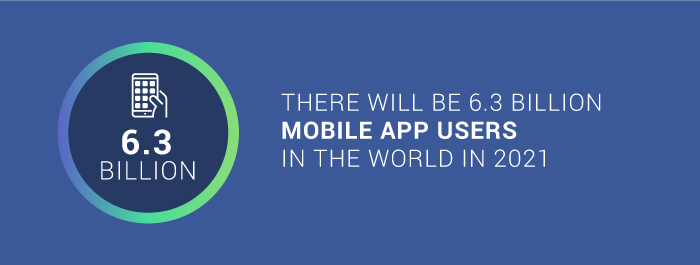Article by: Top App developers

There could be as many as 6.3 billion mobile app users in the world in 2021!
And the app marketplaces are following this trend as well with over 2.57 million apps reported in Google Play app store alone in 2019’s fourth quarter.
These numbers reveal both the huge potential and the fierce competitiveness of the mobile app market.
And, the only way your app idea stands a chance of success in such an environment is if it’s developed methodically and with plenty of forethought.
In this article, we will take a deep look into five steps to take in order to come up with an original and profitable app idea.
We will also discuss, in depth:
- What the most common and most popular types of apps are
- How to validate the viability of your app idea
- How to analyze app idea’s market fit and determine app revenue channels
- How to protect your app idea from abuse
That’s a lot of ground to cover, so let’s begin!
Table of Contents
5 Most Common Types Of Apps
Determining where your mobile app idea fits is an important step toward making your idea into a reality.
Before settling on a mobile app idea – perhaps, even, before beginning to think about it – you should cover some basic app market grounds.
Knowing what are the most common types of apps – in terms of production, popularity and user demand – can bring you a step closer to your niche.
Statista’s 2019 research for both Android and Apple devices show that, for both platforms, these were the five most popular app categories – with slight alterations:
- Games
- Business
- Education
- Lifestyle
- Entertainment
There is a wide variety of apps that fit into an increasingly vast array of categories like tech blog apps, social media, etc. In general, the app market recognizes these 5 most common types of mobile apps and their categories:
- Social media apps such as
- TikTok
- YouTube
- Productivity/Utility apps
- eWallet and banking
- Documents and sheets
- Project management
- Reminders
- Cloud drives
- Mobile Forms
- Lifestyle apps
- Music
- Travel
- Food
- Dating
- Fitness
- Media/Information apps
- LinkedIn Pulse
- Google News
- Financial Times
- Daily Mail
- Game apps

How To Come Up With A Great App Idea In 5 Steps
There may be numerous schools of thought on how to come up with an idea for your app – but there are only several rock-solid advice that work. We will analyze them here.
1. Identify Market Gaps And Consumer Pain Points
Your ideas for a mobile app should develop around the mission of solving users’ specific problems and making their lives simpler.
Plenty of applications that are designed around this idea already exist on the market, so your idea should also focus on how you can do it better than them, with your app.
These user pain points and problems can stem from any area and walk of life, from communication to healthcare.
Identifying what user pain points to base your app idea on will help with defining your target audience later. That’s why it is important to understand that you need to find very specific pain points and focus on them, instead of trying to come up with a one-size-fits-all solution.
So – how can you identify which user pain points to base your app on?
- Look at the apps you use and like with a critical eye: It’s advisable to study the existing mobile apps that are about something you understand well. Are there some weak points they don’t help with? Are some of them underperforming? What would you change to make them better?
- Conduct research: Survey your friends, colleagues and random people online to identify these gaps between what the app market offers and consumers need. Conducting research on your users’ attitudes before the app development will make sure that you build a product that is different from what your competition offers, addressing real pain points that exist in the market.
- Ask the experts: Going directly to app industry veterans and market trends analysts for advice is always an option. These individuals or teams of research specialists have a good overview of what was done in the past and what hasn’t, what has worked and what hasn’t. Their insight will help you understand users’ needs much better.
Resolving each of these steps and understanding what consumer pain points to address with your app will point to a market gap that a well-executed app could fill.
2. Shape Your Business Plan To Establish Your Business’s Purpose
For any enterprise, a business plan is the roadmap of its development and eventual success.
It is a basis on which every facet of your business relies upon and within this business plan, you should outline parameters and stages such as:
- Initial short term goals
- Long term goals
- Growth strategies
- Business vision and mission
- Brand values
Working on these in conjunction with the above-listed user pain points can help identify the business purpose and business goals.
Finding new solutions for achieving your short-term and long-term goals, and looking to implement these solutions into the mobile app development is the key here.
Some of the questions you should ask yourself when defining your business plan – and that will aid your idea brainstorming – are:
- What should my short term and long term business goals be?
- Are these the goals that I can accomplish with an app?
- Which facet of my business and people’s lives will benefit from my app?
- Will the app’s ability to solve the users’ pain points
- What types of features and functionalities should my app have to help me achieve my goals?
3. Follow The Industry Trends To Anticipate Future Needs
The app industry that was yesterday may have already changed today to fit the wants of its demographics and needs of the market.
Having well-defined strategies now is great, but they will not be as effective in the future. And their expiry date is growing shorter as the industry and technology develops.
When you generate your mobile application ideas, they should, ideally, be a reflection of your target market’s current expectations. But as the pursuit of staying up to date with trends is continuous, so should your generating ideas be.
It’s all too easy to find road signs to the latest app trends on the internet.
There is a bounty of information, but – how to avoid being overwhelmed by this overload of insights into industry trends?
Also, not every trend is going to come true or apply to you – so how to make a well-informed decision on which to follow?
Here are a few helpful tips:
- For staying on top of global trends, follow media outlets such as Entrepreneur, Forbes, Trendwatching, TechCrunch and Wired and their expert contributors’ musings on the app market of tomorrow.
- Set up Google Alert for trends that could be more applicable to you and that could have an impact on your own business so you can see how often a trend is mentioned.
- Brainstorm yourself on what kind of apps will be needed in 5 or 10 years’ time. Try to comprehend the future needs of customers and anticipate the change in technology based on current hot topics such as the Internet of Things, augmented reality, wearable tech and blockchain.
- Follow the professional stats and indicators that can help you choose the app category that will be big in the future – such as Statista’s findings on the most popular apps in the App Store.
4. Observe What Your Competition Is Doing To Outperform Them And Be Different
Closing the gaps others have made is often the way to generate ideas and solutions. It’s not always about coming up with completely new concepts from scratch.
There is a certain business strategy that ensures you are always able to catch up with your competitors and outperform them – by replicating what they are doing good. And it’s not about copying someone else.
This tactic is known as a “reactive approach to growth”: as your competition stays on top of the latest trends, upgrades their methods and products and implements all their strategies – you should add your own twist to these by refining them.
Simply put, it’s using competitors’ tactics and methods as a platform upon which to conceive and develop your app idea.
Taking an idea and then morphing it into your own is much harder than it sounds. You need to:
- Examine your competition’s app business strategy to the “T”
- Break it down into smaller components
- Reverse engineer your own app solution
To put yourself in a position to apply this technique, think in terms of these questions:
- What strategies are my competitors using and which are the most successful?
- Which strategies could have worked for them, but haven’t?
- Can I identify gaps and mistakes in their strategies? What are they?
- Can I develop a virtual strategy according to competitors’ experiences, make it better and apply it to my app business idea?
5. Browse Through App Stores For Inspiration
Finally, going directly to the source is never going to be a let-down when looking for new ideas. Study the app categories in App Store and Google Play to find the one where you think you could make a stride with an app solution.
By observing existing app solutions in their “natural habitat” you will get to know them – your competitors better – and find out what solutions they are trying to provide. And whether they are good at it.
Another good source is checking out the lists and charts such as “Top Grossing Apps” or “Apps To Look Out For”. Have successful apps as a criterion for your own when brainstorming mobile application ideas.
Looking at niche categories will also provide valuable insight into the preferences of their target audience in users’ feedback, comments and ratings. Analyze these preferences and expectations carefully – perhaps they’re something you could deliver on?
Likewise, checking out apps’ lists of features, layout and design in screenshots and videos can provide good ground for the development of an app idea.

How To Validate Your Mobile App Idea And Gauge Its Financial Prospects?
When you have a general outline for your app idea, several steps remain to ensure it can be brought to reality.
The first step that follows is the validation of your idea’s merit.
This particular step is to make sure the time, energy and money you invested into your app venture is not in vain.
Checking your idea’s viability is especially important knowing that potential downfalls stem from facts that
- It can cost up to several hundred dollars to build an app
- About 50,000 new apps are added to App Store every month
Here are three effective strategies to evaluate and validate your app idea’s merit:
- Define your target audience: Your app, as any other, should be targeted to a very specific audience. At this stage, you should work on answering the question of who is going to use your app. You can define your audience by
- Researching general facts about your audience, for example, if you are creating a video conference call app, it’s safe to claim that your app’s target audience would be business people.
- Conducting secondary research and deeper analysis for finding more specific info about your audience, for example, the gender or age group using apps such as yours will be when it’s developed.
- Conduct your keyword research: You should come up with several keywords that best describe your app and use tools such as Adwords Google Keyword Planner Tool, SEMRush or Ahrefs to define:
- The search volume or popularity of those keywords – a higher search volume indicates that the keyword is popular and that your app idea is viable.
- How many searches for your keywords happen per month
- What is your keywords’ difficulty, that is how likely it is that people will look for it. The bigger the difficulty, the less chances there are of users’ finding your app.
- Survey your potential users: The most direct approach of validating your idea is often the most efficient: ask your potential users what they think of it. You can survey them using:
- Reddit and subReddits such as /startups or /apps where you can ask members for their honest feedback on your app idea. Reddit is a thriving online community with millions of members and is a great statistical sample for a survey.
- Social media such as Facebook and Twitter pages
App Business Model: Market Fit And Generating Revenue
After validating your idea’s viability and merit, the two next steps to take would be analyzing the idea’s market fit and potential sources of revenue.
Analyze Your App Idea’s Market Fit
Your business needs a good idea of how the monetization model and features of your app will be welcomed by your target audience.
Understanding the app idea’s market fit means to comprehend your potential users behavior – specifically if they would choose your app over any other similar app.
This is where value proposition comes into play. And your app’s features are the characteristics of your value proposition.
To determine your app idea’s market fit:
- Create a spreadsheet containing your app’s features
- Do the same for several apps which you identify as the main competition to compare their features against yours
- Your feature columns should be worded so that each entry for each app can specify the degree to which that app satisfies that feature
- Include the column for your app and competitors’ business models
This process should result in figuring out:
- Differentiator features – that is, features that your competitors do not have and your app does and
- Gap features – the ones your competitors have, but your app doesn’t
When marketing your app idea, communicate your differentiator features to your potential users. Also, try to improve your app idea by adding the gap features you lack. Their absence might affect your app’s rating in the app store.
Identify Your Revenue Channels
One can argue that the quality of an app idea only becomes apparent if you start making money from it.
While revenue is not the only indicator of the app’s worth, it is a valid factor for you, a creator and investor. Your app can generate revenue using these channels:
- In-app ads or sponsored content shown to users
- Paid app with a fixed download price
- Selling physical goods if your app is of eCommerce type
- In-app purchases through the selling of digital services in the app
- Referral/affiliate revenue by referring other businesses to your users
With market fit strategy and monetization model in place, you should reach out to your potential users asking them which app would they download – yours or existing ones by your competitors.
By analyzing how your app idea stacks up to the competition, you can validate whether your target users value your idea enough to choose it over the competition.
How To Protect An App Idea?
The final step before proceeding to the next stage – the actual development of your app – is to ensure your app idea, app’s future content and brand elements are protected.
Here are four efficient ways to protect your app before it’s even out.
- Use Non-Disclosure Agreements: Non-disclosure agreements ensure that, when you share your information with another party, the information remains confidential. Basically, it protects your app idea from being shared or abused by others.
- Choose professional relationships carefully: Working with reputable individuals or businesses is a no-brainer. Because you will likely have to outsource the specialists for developing your app, make sure you research all third party outside help carefully by reading user testimonials, reviews and anything else that implies their reputation and integrity.
- Be careful and selective with who you share your app idea with: It is often necessary to pitch your app idea to clients, developers and other parties, but try to conceal as much as possible and share your idea sparingly. The more you reveal about your app idea, the more likely it is someone may steal it.
- Trademark your app’s name and logo: Since you can patent the final product, but not the idea itself, a great alternative is trademarking your app’s name, logo and other brand elements. According to the law, trademark protects the source, meaning your app’s branding will be used to identify your business with the app when it’s published.
Takeaways On Generating App Ideas
Having a clear idea for your mobile app is merely the first step on a long journey of making your app a profitable reality – but it’s a crucial step that may determine the fate of all others.
When coming up for an app idea for your business, it’s vital to:
- Have a clear overview of potential category or categories in which your app could fit
- Define your target audience and its pain points
- Identify the market gap and your app idea’s differentiator features
- Follow industry trends and predict future developments
- Look to always outdo your competitor’s strategy
- Validate your app idea’s market fit and overall worth
- Protect your app idea by means of NDA and trademarking
